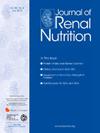Potential Determinants of Subjective Global Assessment Among Patients on Maintenance Hemodialysis
IF 3.2
3区 医学
Q2 NUTRITION & DIETETICS
引用次数: 0
Abstract
Objective
The Subjective Global Assessment (SGA) is a validated tool for identifying nutritional status in patients receiving maintenance hemodialysis (MHD), but it is not without limitations. Current research identifies additional clinical characteristics such as phase angle (PhA) associated with SGA. This study aimed to assess the overall correlation between PhA and SGA; associations between PhA and SGA by body mass index, and to identify clinical characteristics associated with SGA.
Design and Methods
This is a secondary analysis of the Rutgers Nutrition & Kidney Database, which enrolled participants from four primary studies that included adults diagnosed with chronic kidney disease who were receiving MHD. Multivariable binary logistic regression analyses were conducted to estimate odds ratio (OR) and corresponding 95% confidence intervals (CIs).
Results
The study sample included 60.0% males with 81.1% of the sample identifying as African American. Additionally, 38.9% were obese according to the body mass index classification, and 57.0% were moderately malnourished. Patients with obesity had 44% lower odds of being moderately malnourished (OR = 0.56, 95% CI = 0.37, 0.85). In the model adjusted for age and ethnicity and other clinical characteristics, increasing PhA values by one unit was associated with 28% lower odds (OR = 0.72, 95% CI = 0.53, 0.97) of being moderately malnourished while increasing waist circumference (WC) values by one unit was associated with 12% higher odds (OR = 1.12; 95% CI = 1.06, 1.19) of being moderately malnourished than well-nourished. In this fully adjusted model, increasing fat free mass (FFM, OR = 0.95, 95% CI = 0.91, 0.99) and fat mass (FM, OR = 0.92, 95% CI = 0.87, 0.97) by 1 kg was also associated with 5% and 8% lower odds of being moderately malnourished, respectively.
Conclusion
PhA and SGA were significantly associated only among patients classified as obese. PhA, WC, FM, and FFM were identified as potential clinical determinants of SGA. Patients receiving MHD and who have obesity may benefit from utilizing SGA along with WC, PhA, FM, and FFM to assess nutritional status.
维持性血液透析患者主观全面评估的潜在决定因素。
目的:主观全面评估 (SGA) 是确定接受维持性透析 (MHD) 患者营养状况的有效工具,但它并非没有局限性。目前的研究发现了与 SGA 相关的其他临床特征,如相位角 (PhA)。本研究旨在评估 PhA 与 SGA 之间的总体相关性;按体重指数 (BMI) 划分的 PhA 与 SGA 之间的相关性,并确定与 SGA 相关的临床特征:这是对罗格斯营养与肾脏数据库进行的二次分析,该数据库从四项主要研究中招募了参与者,其中包括被诊断患有慢性肾脏病并正在接受MHD治疗的成年人。通过多变量二元逻辑回归分析来估算几率比例(OR)和相应的95%置信区间:研究样本中 60.0% 为男性,81.1% 为非裔美国人。此外,根据体重指数(BMI)分类,38.9%为肥胖,57.0%为中度营养不良。肥胖患者中度营养不良的几率要低 44%(OR=0.56,95% CI=0.37,0.85)。在根据年龄、种族和其他临床特征调整后的模型中,PhA值增加一个单位,中度营养不良的几率降低28%(OR=0.72,95% CI=0.53,0.97),而腰围(WC)值增加一个单位,中度营养不良的几率比营养良好高12%(OR=1.12;95% CI=1.06,1.19)。在这个完全调整模型中,FFM(OR= 0.95,95% CI=0.91,0.99)和FM(OR= 0.92,95% CI=0.87,0.97)增加1公斤也分别与中度营养不良的几率降低5%和8%有关:结论:只有肥胖患者的 PhA 和 SGA 有明显相关性。PhA、WC、FM 和 FFM 被确定为 SGA 的潜在临床决定因素。接受 MHD 的肥胖患者可能会受益于使用 SGA 以及 WC、PhA、FM 和 FFM 来评估营养状况。
本文章由计算机程序翻译,如有差异,请以英文原文为准。
求助全文
约1分钟内获得全文
求助全文
来源期刊

Journal of Renal Nutrition
医学-泌尿学与肾脏学
CiteScore
5.70
自引率
12.50%
发文量
146
审稿时长
6.7 weeks
期刊介绍:
The Journal of Renal Nutrition is devoted exclusively to renal nutrition science and renal dietetics. Its content is appropriate for nutritionists, physicians and researchers working in nephrology. Each issue contains a state-of-the-art review, original research, articles on the clinical management and education of patients, a current literature review, and nutritional analysis of food products that have clinical relevance.
 求助内容:
求助内容: 应助结果提醒方式:
应助结果提醒方式:


